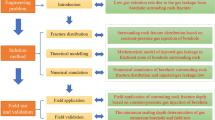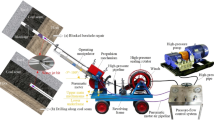Abstract
In order to precisely measure the dilatation energy of the released gas from underground coal seam, this paper initiated a study on the dilatation energy of gas released from underground coal seam by drilling boreholes. Firstly, an in-depth analysis is made on the two major factors causing outburst, which are crustal stress and gas. By establishing mathematical models of unit coal potential energy and gas dilatation energy, authors make a detailed calculation and results comparison. It verifies that the gas dilatation energy is the important and main energy source of a coal seam outburst. Then, the characteristics of dilatation energy of coal seam gas are further stated. Secondly, based on the analysis on the types and features of gas discharge from coal seam and according to the flow field type, this paper divided gas dilatation energy into unidirectional gas dilatation energy, radial gas dilatation energy, and spherical gas dilatation energy. Then, with the assistant of establishing the mathematical model, the software of MATLAB® is used to make numerical calculation on gas dilatation energy release. The results show that dilatation energy of gas released from underground in-seam by drilling boreholes could reflect that coal gas’s ability of expansion work under normal occurrence conditions. Finally, according to the theory of coal seam gas dilatation energy and the features of gas flowing in reducing pipe, on-site measuring method and testing equipment are worked out to measure underground gas dilatation energy. The results of field measurements in a coal mine show that the gas dilatation energy could completely reflect the physical and mechanical properties of crustal stress, gas, and coal. It could be used as a most effective indicator in judging whether coal and gas outburst might occur. Thus, it presents good scientific and practical significances for predicting coal seam outburst.















Similar content being viewed by others
References
Beamish BB, Crosdale PJ (1998) Instantaneous outbursts in underground coal mines: an overview and association with coal type. Int J Coal Geol 35:27–55
Hao J, Yuan C, Zhang Z (2000) Tectonic coal and its effect on the control of the coal and gas outburst prevention and control technology. J Jiaozuo Inst Technol 6:403–406
Hu Q, Zou Y, Wen G (2007) New technology of outburst danger prediction by gas content. J China Coal Soc 32(3):276–280
Jiang C (2000) Linear discriminatory analysis on coal and gas outburst danger and its critical value. J China Univ Min Technol 29:63–66
Jiang C, Yu Q (1995) Spherical shell losing stability hypothesis about outburst mechanism. Saf Coal Mines 2:17–25
Jiang C, Yu Q (1998) Spherical shell instability mechanism of coal and gas outburst and the prevention and control technology. China University of Mining and Technology Press, Xuzhou
Jiang C, Chen S, Chen Y (1996) Measurement of the initial releasing energy of expanding methane from coal. Chin J Rock Mech Eng 15(4):359–400
Lama R, Saghaf A (2002) Overview of gas outbursts and unusual emissions Algeria. In: Aziz N (ed) Coal operators’ conference, University of Wollongong and The Australasian Institute of Mining and Metallurgy, pp 74–88
Lian L, Li L, Wu J (1999) Engineering thermodynamics. China Architecture and Building Press, Beijing
Lin B, Cui H (1998) Theory and technique of methane prevention in coal mine. China University of Mining and Technology Press, Xuzhou
Liu M, Yan A, Ding W, Xu K (2003) Research of thermodynamic process of coal and gas outburst. J China Coal Soc 28(1):50–54
Liu Y, Fu S, Fu A (2008) Study on the calculating methods of gas expansion energy base on thermo kinetic of outburst. J Henan Polytech Univ (Nat Sci) 27(1):1–5
Odintsev VN (1997) Sudden outburst of coal and gas—failure of natural coal as a solution of methane in a solid substance. J Min Sci 33:508–516
Song S, Wang Y (1966) Coal and gas outburst. China Industry Press, Beijing
Wen G (2003) Study of coal and gas outburst energy. Min Saf Environ Prot 30(6):1–3
Wen G, Zhou J, Liu S (2002) Study on intrinsic gas energy to do work in outburst. Min Saf Environ Prot 29(1):1–3
Wold MB, Connell LD, Choi SK (2008) The role of spatial variability in coal seam parameters on gas outburst behavior during coal mining. Int J Coal Geol 75:1–14
Xue S, Xie J, Li X (2009) Study on outbursts of coal and gas in Guqiao Mine of Huainan Coal Mining Group. CSIRO Exploration and Mining Report, Brisbane
Yu B (1985) The mechanism of coal and gas outburst. Press of China Coal Industry Publishing House, Beijing
Yu S (1988) Steady advance of coal and gas bursts. Chin J Theor Appl Mech 20(2):97–106
Yu Q (1992) Mine gas prevention and control. China University of Mining and Technology Press, Xuzhou
Yu B, Wang Y (2000) Handbook of prevention and control of gas disaster in coal mine. Press of China Coal Industry Publishing House, Beijing
Yu B, Wang D (2013) Research on dilatation energy of released gas from coal seam. J Min Saf Eng 30(5):773–777
Yuan F (2011) Mechanics of materials. Zhengzhou University Press, Zhengzhou
Zhang Y (2008) Study on coal and gas outburst regional prediction based on geological structure. Dissertation, Liaoning Technical University
Zheng Z (1982) Study coal and gas outburst mechanism from order of magnitude and dimensional analysis. Peking University Press, Beijing, p 128–137
Zheng Z, Cheng L, Ding Y (1993) Broken front steady advance of one-dimensional gas outbursts. Sci China (Ser A) 23(4):137–184
Zhou S, Lin B (1999) Theory of gas flow and storage in coal seams. Press of China Coal Industry Publishing House, Beijing
Acknowledgments
The authors gratefully thank Ms. Karla J. Vaughan’s efforts to improve the English usages for this paper. This work is financially supported by grants from the Fundamental Research Funds for Central Universities (Grant No. 2013QNA01), the National Science Foundation of China (Grant No. 51304203), the Natural Science Foundation of Jiangsu Province of China for Youths (Grant No. BK20130191) and Specialized Research Fund for the Doctoral Program of Higher Education (Grant No. 20130095120001); the authors are grateful for these supports.
Author information
Authors and Affiliations
Corresponding author
Rights and permissions
About this article
Cite this article
Yu, B., Cheng, J., Yang, S. et al. Characterizing dilatation energy of released gas from underground coal seam by drilling boreholes. Nat Hazards 75, 2965–2984 (2015). https://doi.org/10.1007/s11069-014-1472-1
Received:
Accepted:
Published:
Issue Date:
DOI: https://doi.org/10.1007/s11069-014-1472-1




